Journal of Southern Medical University ›› 2025, Vol. 45 ›› Issue (2): 285-295.doi: 10.12122/j.issn.1673-4254.2025.02.09
Haonan¹ XU1( ), Fang³ ZHANG3, Yuying² HUANG2, Qisheng⁴ YAO4, Yueqin⁴ GUAN4, Hao CHEN1,2,5(
), Fang³ ZHANG3, Yuying² HUANG2, Qisheng⁴ YAO4, Yueqin⁴ GUAN4, Hao CHEN1,2,5( )
)
Received:2024-11-25
Online:2025-02-20
Published:2025-03-03
Contact:
Hao CHEN
E-mail:2770863077@qq.com;chenhao@ahstu.edu.cn
Supported by:Haonan¹ XU, Fang³ ZHANG, Yuying² HUANG, Qisheng⁴ YAO, Yueqin⁴ GUAN, Hao CHEN. Thesium chinense Turcz. alleviates antibiotic-associated diarrhea in mice by modulating gut microbiota structure and regulating the EGFR/PI3K/Akt signaling pathway[J]. Journal of Southern Medical University, 2025, 45(2): 285-295.
Add to citation manager EndNote|Ris|BibTeX
URL: https://www.j-smu.com/EN/10.12122/j.issn.1673-4254.2025.02.09
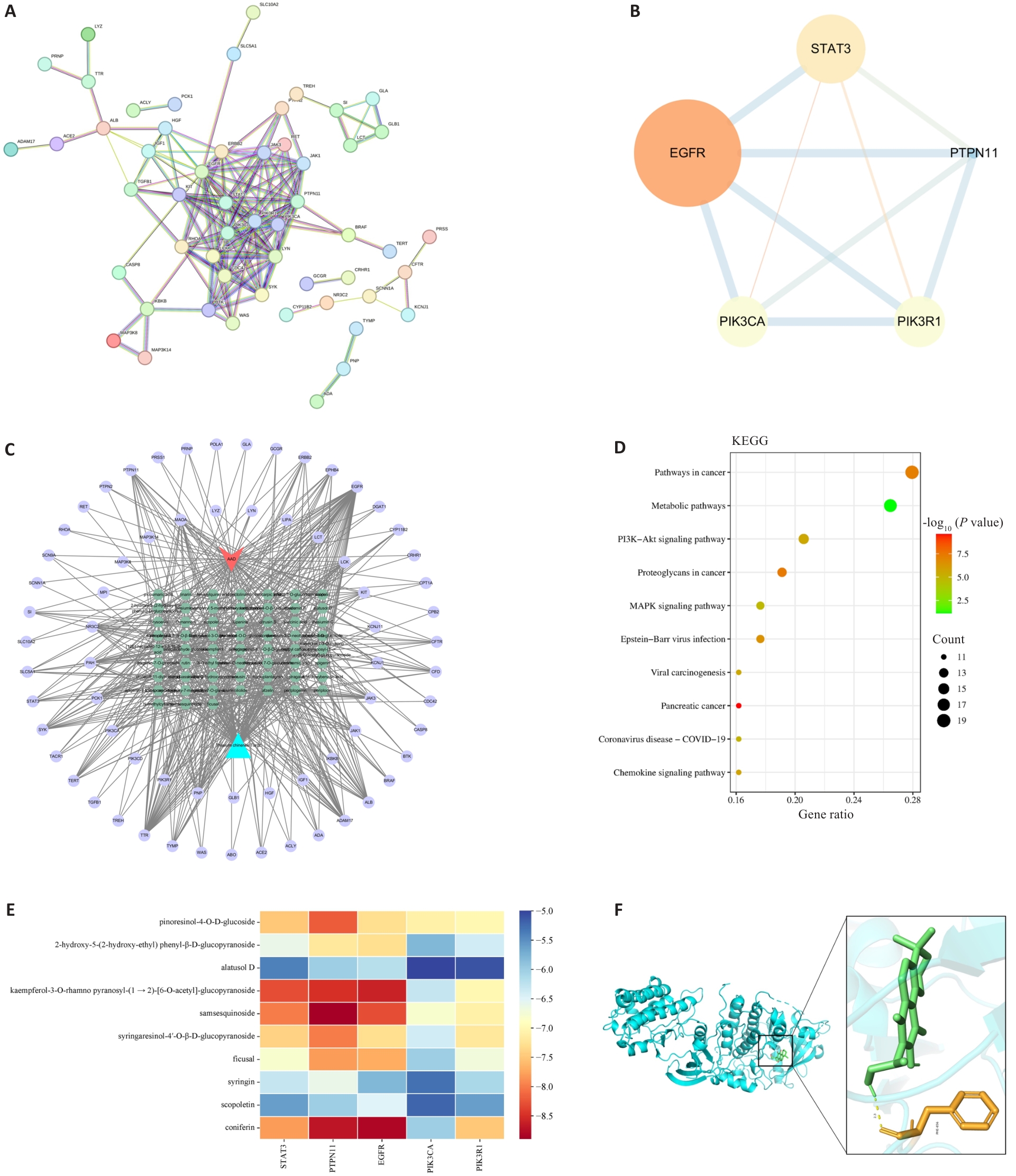
Fig.1 Network pharmacology analysis of Thesium chinense Turcz. (TCT) in treating AAD. A: PPI network. B: Core target map. C: "Disease-drug-compound-gene" network. D: KEGG pathway enrichment map. E: Heatmap of molecular docking results. F: Schematic diagram of EGFR binding with coniferin.
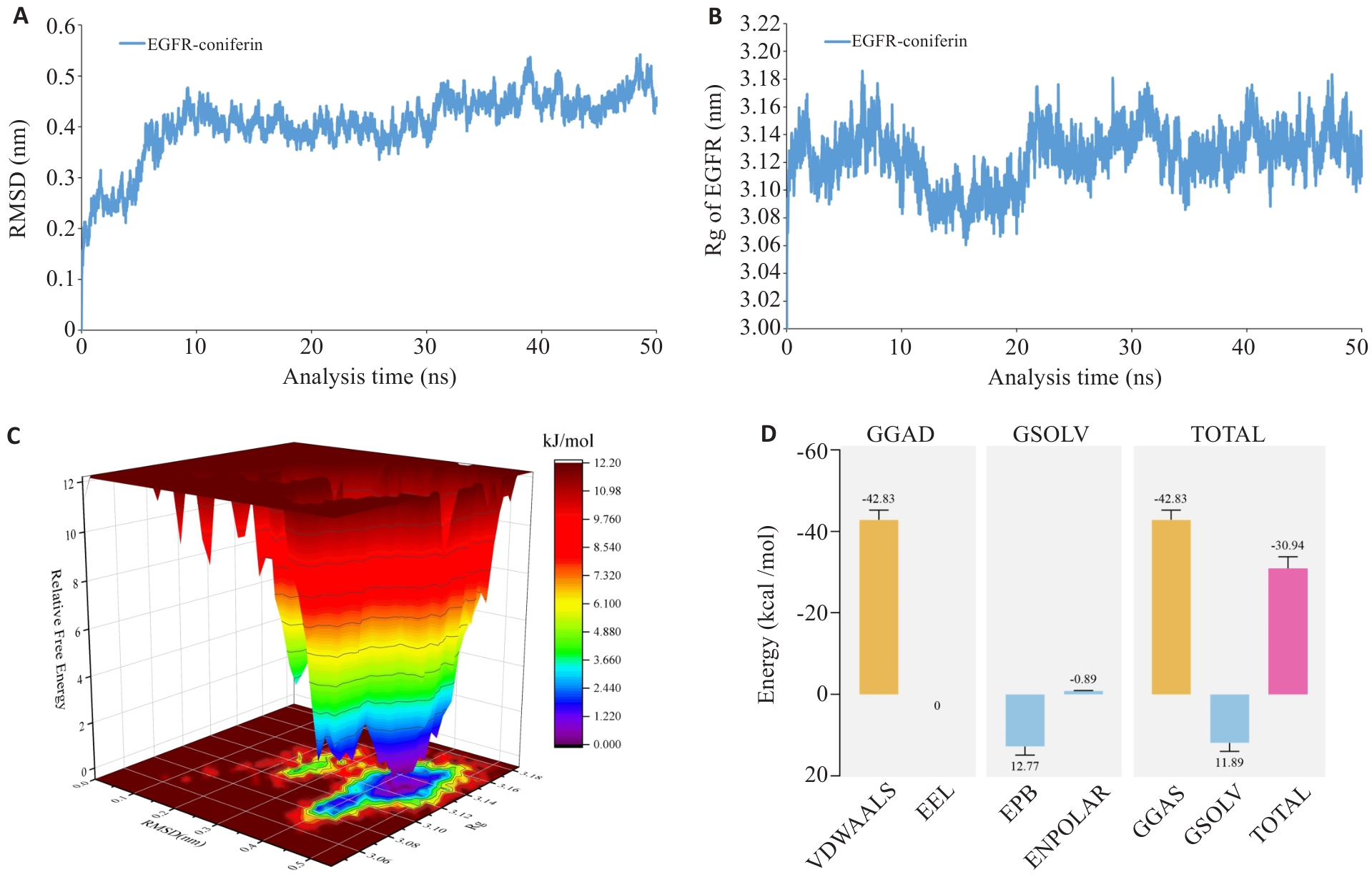
Fig.2 Molecular docking and molecular dynamics simulation analysis of EGFR with coniferin. A: RMSD analysis. B: Radius of gyration analysis of EGFR. C: Gibbs free energy landscape. D: MM/PBSA binding free energy plot.

Fig.4 Pathological examination of the colonic tissue of the mice in each group (HE staining, original magnification:×200). Arrows indicated inflammatory cell infiltration.

Fig.5 ELISA for detecting TNF-α (A) and IL-6 (B) levels in mouse colon tissues in each group. ###P<0.001 vs control group, ***P<0.001 vs NR group (n=6).
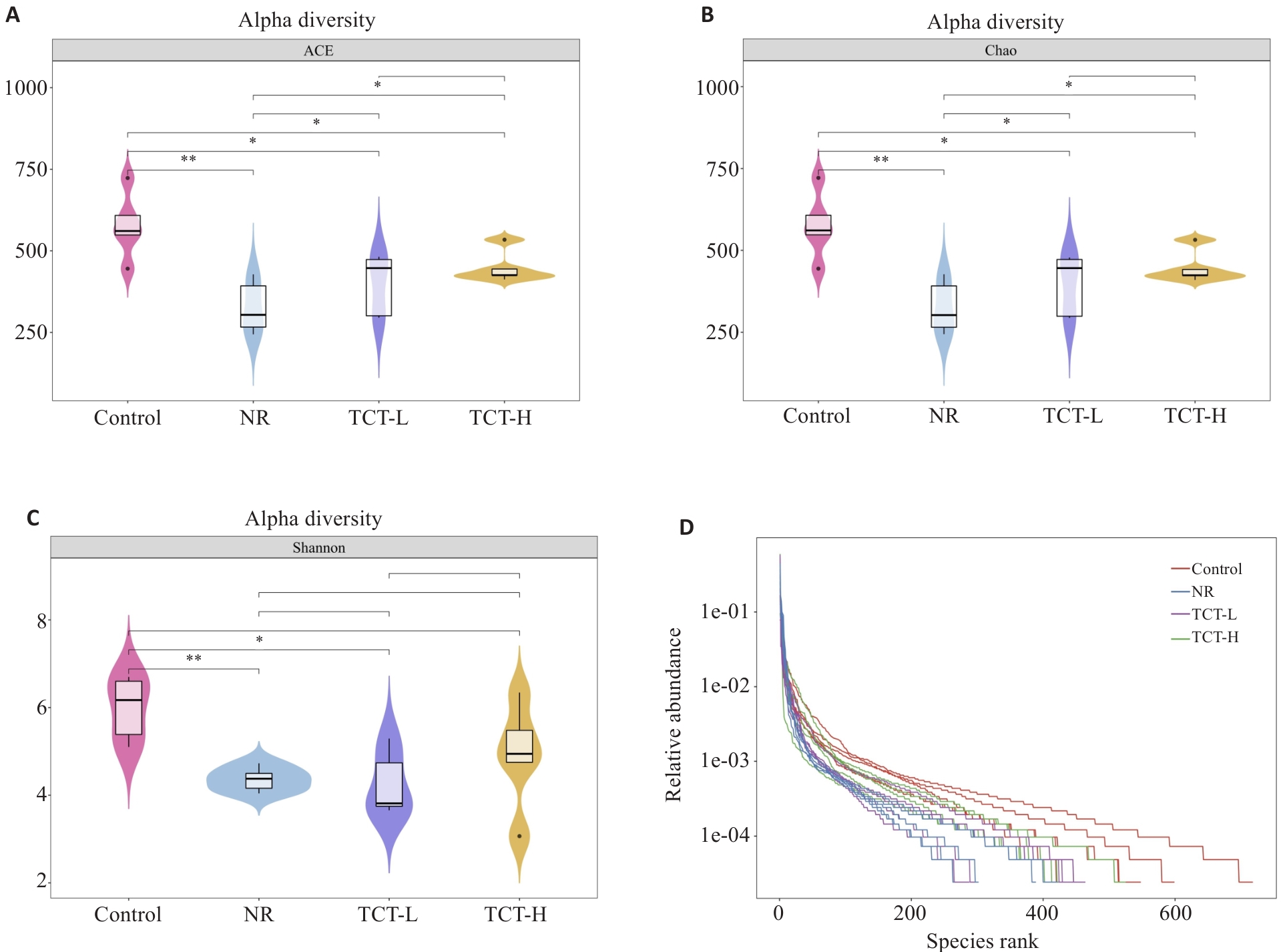
Fig.6 Changes of alpha diversity in the gut microbiota of the mice. A: ACE index. B: Chao index. C: Shannon index. D: Species rank abundance curve. *P<0.05, **P<0.01 (n=5).
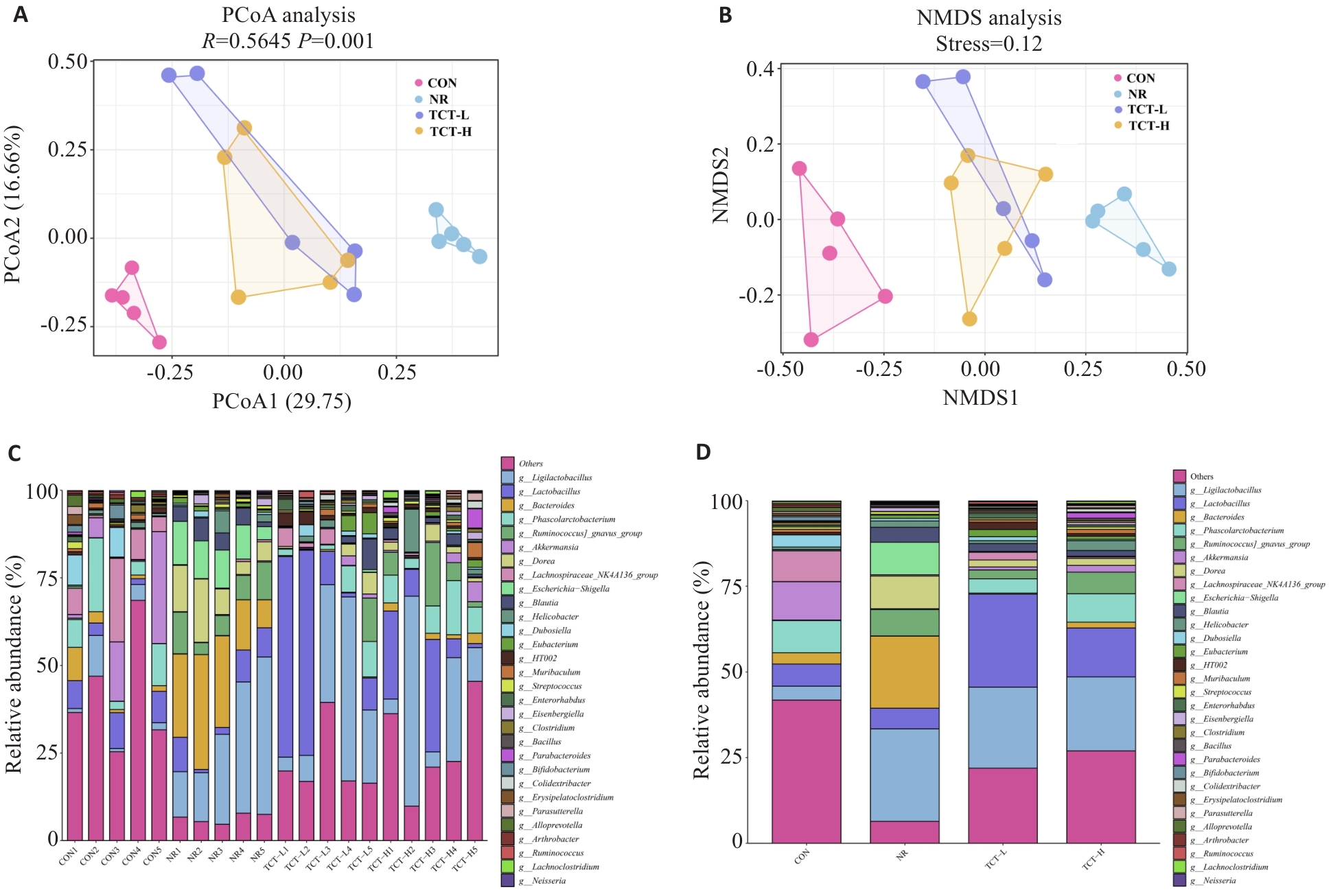
Fig.7 Beta diversity analysis and microbiota composition analysis (n=5). A: PCoA plot. B: NMDS plot. C: Bar plot of genus-level community composition among samples. D: Bar plot of genus-level community composition among groups.
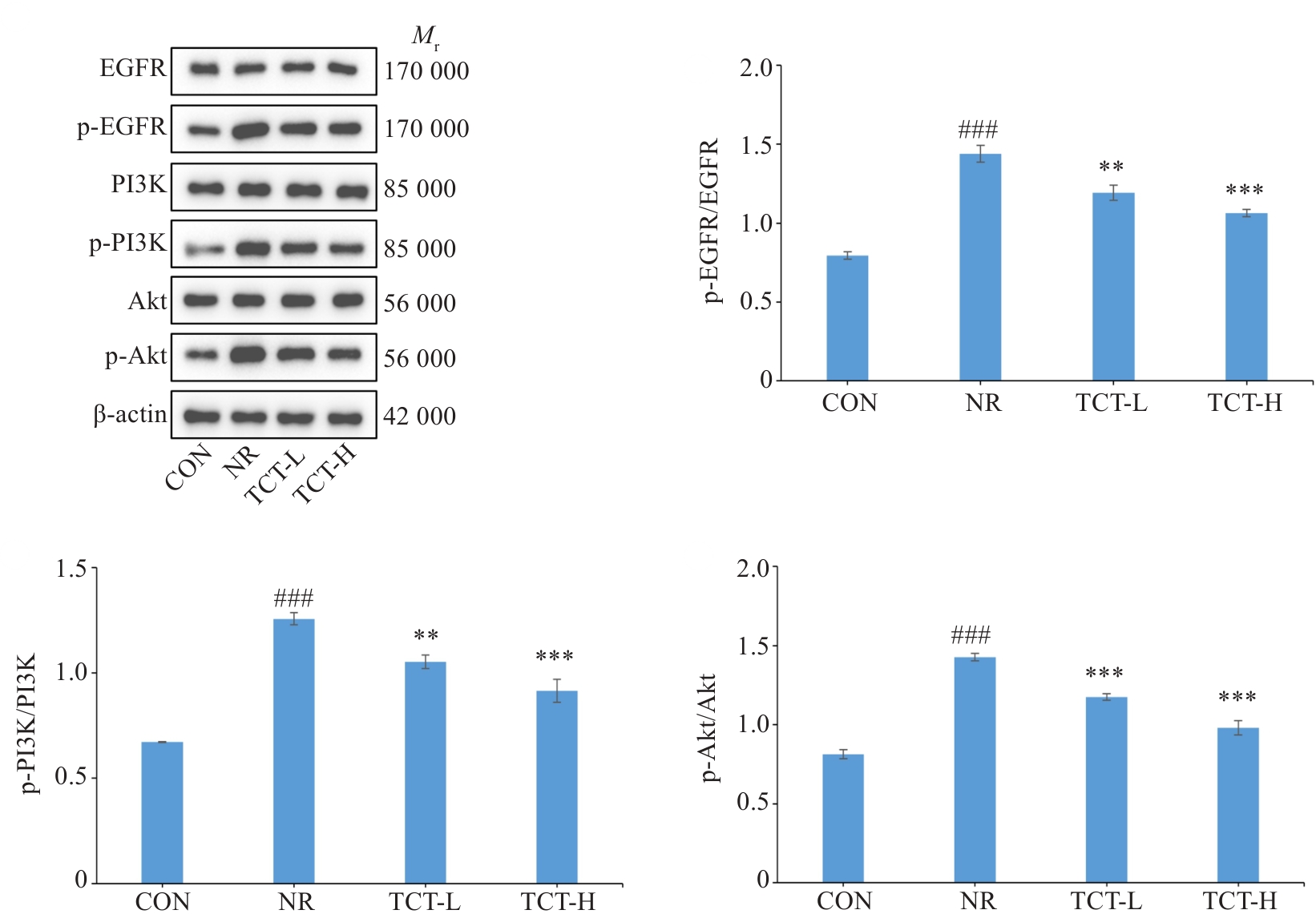
Fig.9 Expression levels of EGFR, PI3K, Akt and their phosphorylated proteins in the colon tissues of the mice in each group. ###P<0.001 vs control group, **P<0.01, ***P<0.001 vs NR group (n=3).
| 1 | Nanayakkara AK, Boucher HW, Fowler VG Jr, et al. Antibiotic resistance in the patient with cancer: escalating challenges and paths forward[J]. CA Cancer J Clin, 2021, 71(6): 488-504. |
| 2 | Hui HY, Wu Y, Zheng T, et al. Bacterial characteristics in intestinal contents of antibiotic-associated diarrhea mice treated with qiweibaizhu powder[J]. Med Sci Monit, 2020, 26: e921771. |
| 3 | Sun HM, Huang JP, Zhou YJ, et al. Antibiotic exposure and risk of overweight/obesity in children: a biomonitoring-based study from eastern Jiangsu, China[J]. Front Public Health, 2024, 12: 1494511. |
| 4 | Mekonnen SA, Merenstein D, Fraser CM, et al. Molecular mechanisms of probiotic prevention of antibiotic-associated diarrhea[J]. Curr Opin Biotechnol, 2020, 61: 226-34. |
| 5 | Ma ZJ, Wang HJ, Ma XJ, et al. Modulation of gut microbiota and intestinal barrier function during alleviation of antibiotic-associated diarrhea with Rhizoma Zingiber officinale (Ginger) extract[J]. Food Funct, 2020, 11(12): 10839-51. |
| 6 | Guo YN, Wang J, Zhang HJ, et al. Traditional Chinese medicine QPYF as preventive treatment for Clostridium difficile associated diarrhea in a mouse model[J]. Evid Based Complement Alternat Med, 2016, 2016: 3759819. |
| 7 | Li XY, Wu YY, Xu ZY, et al. Effects of hetiao Jianpi Decoction on intestinal injury and repair in rats with antibiotic-associated diarrhea[J]. Med Sci Monit, 2020, 26: e921745. |
| 8 | Fu SL, Sun LS, Chen YD, et al. Effect of traditional Chinese medicine on treating antibiotic-associated diarrhea in children: a systematic review and meta-analysis[J]. Evid Based Complement Alternat Med, 2022, 2022: 6108772. |
| 9 | Liu C, Li XT, Cheng RR, et al. Anti-oral common pathogenic bacterial active acetylenic acids from Thesium chinense Turcz[J]. J Nat Med, 2018, 72(2): 433-8. |
| 10 | Wei JR, Zhang C, Ma W, et al. Antibacterial activity of Thesium chinense Turcz extract against bacteria associated with upper respiratory tract infections[J]. Infect Drug Resist, 2023, 16: 5091-105. |
| 11 | Ma JC, Wei JR, Chen G, et al. Extracts of Thesium chinense inhibit SARS-CoV-2 and inflammation in vitro [J]. Pharm Biol, 2023, 61(1): 1446-53. |
| 12 | Li S, Zhang B. Traditional Chinese medicine network pharmacology: theory, methodology and application[J]. Chin J Nat Med, 2013, 11(2): 110-20. |
| 13 | Decherchi S, Cavalli A. Thermodynamics and kinetics of drug-target binding by molecular simulation[J]. Chem Rev, 2020, 120(23): 12788-833. |
| 14 | Hendam A, Al-Sadek AF, Hefny HA. Molecular dynamic simulation of Neurexin1α mutations associated with mental disorder[J]. J Mol Neurosci, 2022, 72(11): 2252-72. |
| 15 | Li L, Ju JF, Zhuang XP, et al. Chemistry of Bairui Granules and its mechanisms in the protective effect against methotrexate-induced liver injury[J]. Phytomedicine, 2024, 122: 155158. |
| 16 | Liu ZZ, Ma JC, Deng P, et al. Chemical constituents of Thesium chinense Turcz and their in vitro antioxidant, anti-inflammatory and cytotoxic activities[J]. Molecules, 2023, 28(6): 2685. |
| 17 | Seeliger D, de Groot BL. Ligand docking and binding site analysis with PyMOL and Autodock/Vina[J]. J Comput Aided Mol Des, 2010, 24(5): 417-22. |
| 18 | Uchibori K, Inase N, Araki M, et al. Brigatinib combined with anti-EGFR antibody overcomes osimertinib resistance in EGFR-mutated non-small-cell lung cancer[J]. Nat Commun, 2017, 8: 14768. |
| 19 | Miller BR 3rd, McGee TD Jr, Swails JM, et al. MMPBSA.py: an efficient program for end-state free energy calculations[J]. J Chem Theory Comput, 2012, 8(9): 3314-21. |
| 20 | Xu Y, Liang XH, Hyun CG. Isolation, characterization, genome annotation, and evaluation of tyrosinase inhibitory activity in secondary metabolites of Paenibacillus sp. JNUCC32: a comprehensive analysis through molecular docking and molecular dynamics simulation[J]. Int J Mol Sci, 2024, 25(4): 2213. |
| 21 | Kumari R, Kumar R, Open Source Drug Discovery Consortium, et al. G_mmpbsa: a GROMACS tool for high-throughput MM-PBSA calculations[J]. J Chem Inf Model, 2014, 54(7): 1951-62. |
| 22 | Vicentini FA, Keenan CM, Wallace LE, et al. Intestinal microbiota shapes gut physiology and regulates enteric neurons and glia[J]. Microbiome, 2021, 9(1): 210. |
| 23 | Bartlett JG. Antibiotic-associated diarrhea[J]. Clin Infect Dis, 1992, 15(4): 573-81. |
| 24 | Zhang T, Li QQ, Cheng L, et al. Akkermansia muciniphila is a promising probiotic[J]. Microb Biotechnol, 2019, 12(6): 1109-25. |
| 25 | Wu HQ, Xie S, Miao JF, et al. Lactobacillus reuteri maintains intestinal epithelial regeneration and repairs damaged intestinal mucosa[J]. Gut Microbes, 2020, 11(4): 997-1014. |
| 26 | Qi YL, Chen LX, Gao K, et al. Effects of Schisandra chinensis polysaccharides on rats with antibiotic-associated diarrhea[J]. Int J Biol Macromol, 2019, 124: 627-34. |
| 27 | Peng GC, Hao JH, Guan YQ, et al. Systematic investigation of the material basis, effectiveness and safety of Thesium chinense Turcz. and its preparation Bairui Granules against lung inflammation[J]. Chin Med, 2024, 19(1): 67. |
| 28 | Shu XY, Xu RT, Xiong PY, et al. Exploring the effects and potential mechanisms of hesperidin for the treatment of CPT-11-induced diarrhea: network pharmacology, molecular docking, and experimental validation[J]. Int J Mol Sci, 2024, 25(17): 9309. |
| 29 | Masudur Rahman Munna M, Touki Tahamid Tusar M, Sajnin Shanta S, et al. Unveiling promising phytocompounds from Moringa oleifera as dual inhibitors of EGFR(T790M/C797S) and VEGFR-2 in non-small cell lung cancer through in silico screening, ADMET, dynamics simulation, and DFT analysis[J]. J Genet Eng Biotechnol, 2024, 22(3): 100406. |
| 30 | Sameh S, Elissawy AM, Al-Sayed E, et al. Family Malvaceae: a potential source of secondary metabolites with chemopreventive and anticancer activities supported with in silico pharmacokinetic and pharmacodynamic profiles[J]. Front Pharmacol, 2024, 15: 1465055. |
| 31 | Ren DD, Li SS, Lin HM, et al. Panax quinquefolius polysaccharides ameliorate antibiotic-associated diarrhoea induced by lincomycin hydrochloride in rats via the MAPK signaling pathways[J]. J Immunol Res, 2022, 2022: 4126273. |
| 32 | Kim JH, Kim M, Kim JM, et al. Afzelin suppresses proinflammatory responses inparticulate matter-exposed human keratinocytes[J]. Int J Mol Med, 2019, 43(6): 2516-22. |
| 33 | Cresci G, Nagy LE, Ganapathy V. Lactobacillus GG and tributyrin supplementation reduce antibiotic-induced intestinal injury[J]. JPEN J Parenter Enteral Nutr, 2013, 37(6): 763-74. |
| 34 | Rajaram P, Chandra P, Ticku S, et al. Epidermal growth factor receptor: role in human cancer[J]. Indian J Dent Res, 2017, 28(6): 687-94. |
| 35 | Chen JM, Li M, Chen R, et al. Gegen Qinlian standard decoction alleviated irinotecan-induced diarrhea via PI3K/AKT/NF-κB axis by network pharmacology prediction and experimental validation combination[J]. Chin Med, 2023, 18(1): 46. |
| 36 | Liu MQ, Sun HY, Fu H, et al. 7-hydroxycoumarin ameliorates ulcerative colitis in mice by inhibiting the MAPK pathway and alleviating gut microbiota dysbiosis[J]. BMC Gastroenterol, 2024, 24(1): 405. |
| [1] | Qiao CHU, Xiaona WANG, Jiaying XU, Huilin PENG, Yulin ZHAO, Jing ZHANG, Guoyu LU, Kai WANG. Pulsatilla saponin D inhibits invasion and metastasis of triple-negative breast cancer cells through multiple targets and pathways [J]. Journal of Southern Medical University, 2025, 45(1): 150-161. |
| [2] | Xiupeng LONG, Shun TAO, Shen YANG, Suyun LI, Libing RAO, Li LI, Zhe ZHANG. Quercetin improves heart failure by inhibiting cardiomyocyte apoptosis via suppressing the MAPK signaling pathway [J]. Journal of Southern Medical University, 2025, 45(1): 187-196. |
| [3] | Meng XU, Lina CHEN, Jinyu WU, Lili LIU, Mei SHI, Hao ZHOU, Guoliang ZHANG. Mechanism of Hedyotis diffusa-Scutellaria barbata D. Don for treatment of primary liver cancer: analysis with network pharmacology, molecular docking and in vitro validation [J]. Journal of Southern Medical University, 2025, 45(1): 80-89. |
| [4] | Qing LIU, Jing LIU, Yihang ZHENG, Jin LEI, Jianhua HUANG, Siyu LIU, Fang LIU, Qunlong PENG, Yuanfang ZHANG, Junjie WANG, Yujuan LI. Quercetin mediates the therapeutic effect of Centella asiatica on psoriasis by regulating STAT3 phosphorylation to inhibit the IL-23/IL-17A axis [J]. Journal of Southern Medical University, 2025, 45(1): 90-99. |
| [5] | Xingmei CHEN, Qinwen LIU, Yi LI, Xiaoyu ZHONG, Qiling FAN, Ke MA, Liuting LUO, Daogang GUAN, Zhibo ZHU. Analysis of core functional components in Yinchenhao Decoction and their pathways for treating liver fibrosis [J]. Journal of Southern Medical University, 2024, 44(8): 1508-1517. |
| [6] | Shanyuan ZHANG, Qiaoyan CAI, Jianghan QI, Kaixin YIN, Chenchen HE, Zhuye GAO, Ling ZHANG, Jianfeng CHU. Pharmacodynamics of Qingxin Jieyu Granules for treatment of atherosclerosis and its regulatory mechanism for lipid metabolism [J]. Journal of Southern Medical University, 2024, 44(8): 1518-1528. |
| [7] | Yuming ZHANG, Shicheng XIA, Linlin ZHANG, Mengxi CHEN, Xiaojing LIU, Qin GAO, Hongwei YE. Protective effect of Lonicerae japonicae flos extract against doxorubicin-induced liver injury in mice [J]. Journal of Southern Medical University, 2024, 44(8): 1571-1581. |
| [8] | Jinjin WANG, Wenfei CUI, Xuewei DOU, Binglei YIN, Yuqi NIU, Ling NIU, Guoli YAN. Euonymus alatus delays progression of diabetic kidney disease in mice by regulating EGFR tyrosine kinase inhibitor resistance signaling pathway [J]. Journal of Southern Medical University, 2024, 44(7): 1243-1255. |
| [9] | Linyue WANG, Wenyue QI, Jihua GAO, Maosheng TIAN, Jiancheng XU. Tongyangxiao Lotion promotes postoperative wound healing in a rat model of anal fistula by downregulating inflammatory factors and suppressing inflammation [J]. Journal of Southern Medical University, 2024, 44(7): 1256-1265. |
| [10] | Wenxiang ZHANG, Huixian GU, Pengde CHEN, Siyu WU, Hongyan MA, Lan YAO. Compound Yuye Decoction protects diabetic rats against cardiomyopathy by inhibiting myocardial apoptosis and inflammation via regulating the PI3K/Akt signaling pathway [J]. Journal of Southern Medical University, 2024, 44(7): 1306-1314. |
| [11] | Yan HUANG, Lulu QIN, Shaoxing GUAN, Yanping GUANG, Yuru WEI, Ailing CAO, Dongmei LI, Guining WEI, Qibiao SU. Therapeutic mechanism of aqueous extract of Semiliquidambar cathayensis Chang root for pancreatic cancer: the active components, therapeutic targets and pathways [J]. Journal of Southern Medical University, 2024, 44(7): 1336-1344. |
| [12] | Zhijun REN, Jianxin DIAO, Yiting WANG. Xionggui Decoction alleviates heart failure in mice with myocardial infarction by inhibiting oxidative stress-induced cardiomyocyte apoptosis [J]. Journal of Southern Medical University, 2024, 44(7): 1416-1424. |
| [13] | Ruibo LI, Ge GAO, Xi XIE, Haibin LUO. Oral submucosal fibrosis induced by active components in areca nut: a network pharmacology-based analysis and validation of the mechanism [J]. Journal of Southern Medical University, 2024, 44(5): 930-940. |
| [14] | LI Yunfei, YANG Jingyi, ZHANG Ying, ZHANG Caixia, WEI Yuxiang, WANG Yiying, WU Ning, SUN Jianfei, WU Zunqiu. The Miao medicine Sidaxue alleviates rheumatoid arthritis in rats possibly by downregulating matrix metalloproteinases [J]. Journal of Southern Medical University, 2024, 44(4): 739-747. |
| [15] | CHEN Junjie, HUANG Chuanbing, LI Ming. Jianpi Zishen granule inhibits podocyte autophagy in systemic lupus erythematosus: a network pharmacology and clinical study [J]. Journal of Southern Medical University, 2024, 44(3): 465-473. |
| Viewed | ||||||
|
Full text |
|
|||||
|
Abstract |
|
|||||